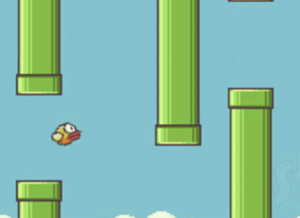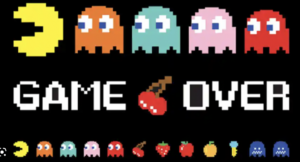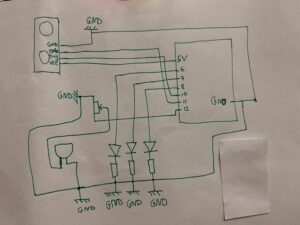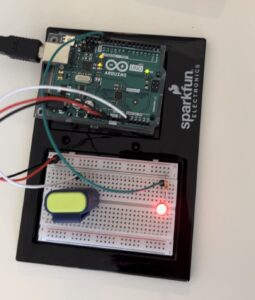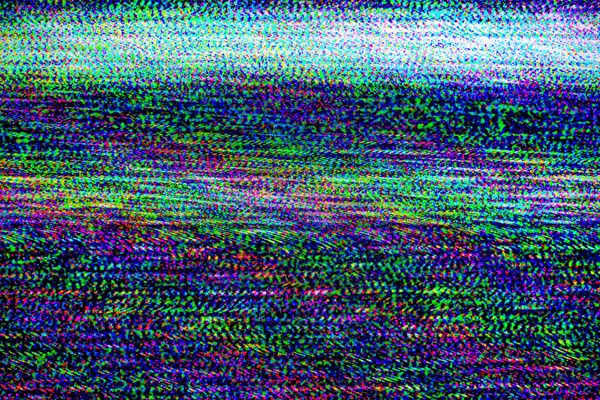Concept:
Neuro-jump is an interactive game that aims to challenge its users and encourage them to think about using their body as an interaction tool that allows them to interact with technology. Neuro-jump detects the user’s EMG-muscle signals and allows them to control the jumping Alien cowboy by flexing their bicep muscle
This game is a critique to the status quo of video games and technology in general and an invitation to steer away from using the basic interactive tools such us touch screens and hand held items, and to think about the possibility of employing different techniques.
User testing:
Throughout the process of developing the game I have tried different settings and techniques. I have noticed that some people do very well whereas others struggle to play it. After multiple tests I figured out the best level of difficulty that is not too challenging but not too boring at this same time. I also implemented a slider that allows the users to change the height of the jump of the alien thus making the game easier.
Implementation:
I have used P5 and Arduino to link the EMG signal detecting electrodes with the P5 side of the game. Setting the serial connection was not a very big challenge for me as I made sure only the necessary data will be ent form the Arduino to the computer which will make the user interaction instant and very fast and effective. I have also used the brain-shield gadget that allowed me to detect the EMG signal and transition them into digital data.
The game allows the user to both jump the incoming obstacles by flexing their hand but to also shoot the harmful birds by pressing the space Bar.
For the Arduino code I have used the original script that came with the hardware but I had to change and alter it to make it send the strength signal and use it in the length.
Future improvements and reflections:
I would like to implement the strength of the flex in the game and maybe make the jump or the attack depend on the strength of the flex. I would also like to add other tools that would allow the game to be played by two players instead of one, and maybe add another character and make the game a competitive. I would also like to create a “button-free” game the users can manipulate without the use of their hands but just their movement, facial expression or body position. I want to experiment mare with Interactivity and allow the users to be creative and have a fun time without the need of buttons or touch screens. For Neuro-Jump I would like to implement a program that detects facial gesture or body tracking that would allow the user the control the character.
P5:
Arduino code:
/*
* --------------------------------------------------------------------------------------
* Code monitors amplitude of EMG envelope, displays EMG strength on LED bar and controls
* robotic gripper by controlling servo motor.
* --------------------------------------------------------------------------------------
*/
#include <Servo.h>
#define GRIPPER_STATE_BUTTON_PIN 4 //pin for button that switches defult state
//of the gripper (opened/closed)
#define SERVO_PIN 2 //pin for servo motor
#define SENSITIVITY_BUTTON_PIN 7 //pin for button that selects sesitivity
#define NUM_LED 6 //number of LEDs in LED bar
#define GRIPPER_MINIMUM_STEP 5 //5 degree dead zone (used to avoid
//aiming oscilation)
#define OPEN_MODE 1 //default gripper state is opened
#define CLOSED_MODE 2 //default gripper state is closed
#define MINIMUM_SERVO_UPDATE_TIME 100 //update servo position every 100ms
#define Max_EMG_LED 3
Servo Gripper; //servo for gripper
byte ledPins[] = {8, 9, 10, 11, 12, 13}; //pins for LEDs in LED bar
//EMG saturation values (when EMG reaches this value
//the gripper will be fully opened/closed)
int sensitivities[] = {200, 350, 520, 680, 840, 1000};
int lastSensitivitiesIndex = 2; //set initial sensitivity index
int emgSaturationValue = 0; //selected sensitivity/EMG saturation value
int analogReadings; //measured value for EMG
byte ledbarHeight = 0; //temporary variable for led bar height
unsigned long oldTime = 0; //timestamp of last servo angle update (ms)
int oldDegrees = 0; //old value of angle for servo
int newDegree; //new value of angle for servo
unsigned long debouncerTimer = 0; //timer for button debouncer
int gripperStateButtonValue = 0; //variable that stores state of button
int userReleasedButton = 1; //flag that is used to avoid multiple
//button events when user holds button
int currentFunctionality = OPEN_MODE; //current default position of claw
//-----------------------------------------------------------------------------------
// Setup servo, inputs and outputs
// ----------------------------------------------------------------------------------
void setup(){
Serial.begin(9600);
//init servo
Gripper.attach(SERVO_PIN);
//init button pins to input
pinMode(GRIPPER_STATE_BUTTON_PIN, INPUT);
pinMode(SENSITIVITY_BUTTON_PIN, INPUT);
//initialize all LED pins to output
for(int i = 0; i < NUM_LED; i++){
pinMode(ledPins[i], OUTPUT);
}
//get current sensitivity
emgSaturationValue = sensitivities[lastSensitivitiesIndex];
}
//-----------------------------------------------------------------------------------
// Main loop
//
// - Checks state of sesitivity button
// - Checks state of default-gripper-state button
// - Measure EMG
// - Shows EMG strength on LED bar
// - Sets angle of servo based on EMG strength and current mode (open/closed)
// ----------------------------------------------------------------------------------
void loop()
{
//----------------------- Switch sensitivity ------------------------------------
//check if button is pressed (HIGH)
if (digitalRead(SENSITIVITY_BUTTON_PIN))
{
//turn off all the LEDs in LED bar
for(int j = 0; j < NUM_LED; j++)
{
digitalWrite(ledPins[j], LOW);
}
//increment sensitivity index
lastSensitivitiesIndex++;
if(lastSensitivitiesIndex==NUM_LED)
{
lastSensitivitiesIndex = 0;
}
//get current sensitivity value
emgSaturationValue = sensitivities[lastSensitivitiesIndex];
//light up LED at lastSensitivitiesIndex position for visual feedback
digitalWrite(ledPins[lastSensitivitiesIndex], HIGH);
//wait user to release button
while (digitalRead(SENSITIVITY_BUTTON_PIN))
{
delay(10);
}
//whait a bit more so that LED light feedback is always visible
delay(100);
}
//---------------------------- Switch gripper default position open/close ---------
//check if enough time has passed for button contact to settle down
if((millis() - debouncerTimer) > 50)
{
gripperStateButtonValue = digitalRead(GRIPPER_STATE_BUTTON_PIN);
//if button is pressed
if(gripperStateButtonValue == HIGH)
{
//if last time we checked button was not pressed
if(userReleasedButton)
{
debouncerTimer = millis();
//block button events untill user releases it
userReleasedButton = 0;
//toggle operation mode
if(currentFunctionality == OPEN_MODE)
{
currentFunctionality = CLOSED_MODE;
}
else
{
currentFunctionality = OPEN_MODE;
}
}
}
else
{
userReleasedButton = 1;
}
}
//----------------------------- Measure EMG ---------------------------------------
analogReadings = analogRead(A0);//read EMG value from analog input A0
//---------------------- Show EMG strength on LED ----------------------------------
//turn OFF all LEDs on LED bar
for(int j = 0; j < NUM_LED; j++)
{
digitalWrite(ledPins[j], LOW);
}
//calculate what LEDs should be turned ON on the LED bar
analogReadings= constrain(analogReadings, 30, emgSaturationValue);
ledbarHeight = map(analogReadings, 30, emgSaturationValue, 0, NUM_LED);
//turn ON LEDs on the LED bar
for(int k = 0; k < ledbarHeight; k++)
{
digitalWrite(ledPins[k], HIGH);
}
//-------------------- Send EMG strength data over serial -----------------------
Serial.println(analogReadings);
//-------------------- Drive Claw according to EMG strength -----------------------
//set new angle if enough time passed
if (millis() - oldTime > MINIMUM_SERVO_UPDATE_TIME)
{
//calculate new angle for servo
if(currentFunctionality == OPEN_MODE)
{
analogReadings = constrain(analogReadings, 40, emgSaturationValue);
newDegree = map(analogReadings, 40 ,emgSaturationValue, 190, 105);
}
else
{
analogReadings = constrain(analogReadings, 120, emgSaturationValue);
newDegree = map(analogReadings, 120 ,emgSaturationValue, 105, 190);
}
//check if we are in servo dead zone
if(abs(newDegree-oldDegrees) > GRIPPER_MINIMUM_STEP)
{
//set new servo angle
Gripper.write(newDegree);
}
oldTime = millis();
oldDegrees = newDegree;
}
}


